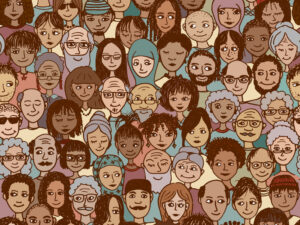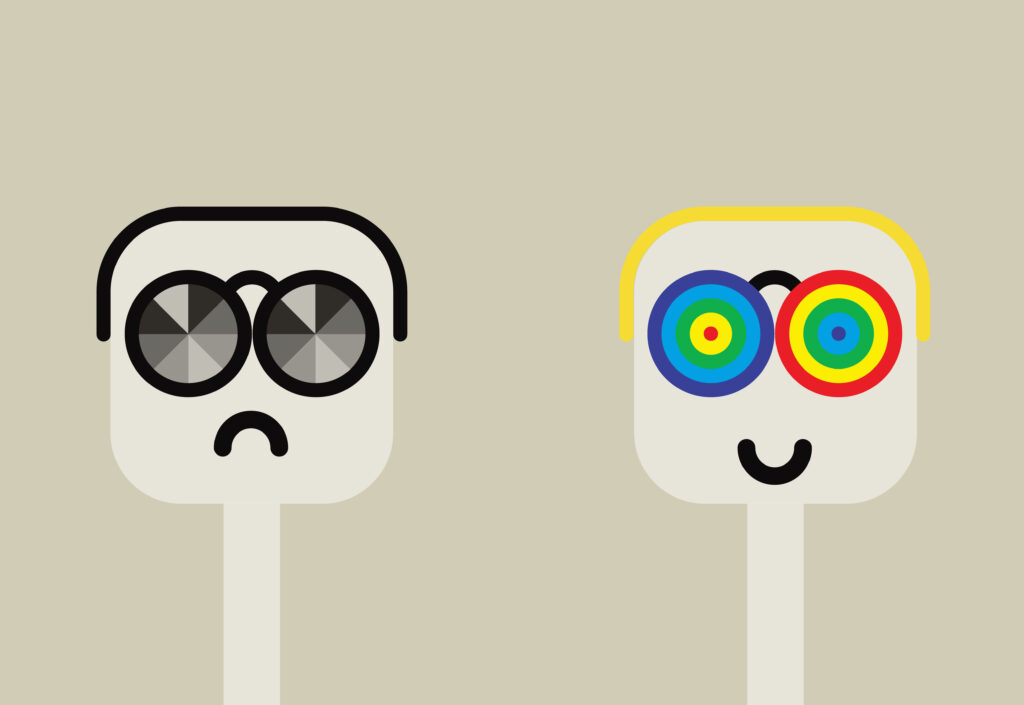 Kris English, PhD
Kris English, PhD
Professor Emeritus of Audiology
The University of Akron
Most White adults in the United States (~70%) describe themselves as “colorblind” to race.1 For non-US readers, the term means that the color of a person’s skin does not matter in today’s society, and is communicated by statements such as “I don’t see race, I only see the human race.”2,3
Colorblind racial ideology (CBRI) is meant to overrule any impression of prejudice4 even as it distances the speaker from the lived experiences of people of color.5,6 In all fairness, it might also intend to express a sincere desire to support a more just society.7
However, even when based on good intentions, racial colorblindness is at odds with audiology counseling principles. Following are three fundamental difficulties:
1. A Colorblind Stance Lacks Honesty
The position “I don’t see race” is factually not true. Neurological research indicates that when we look at an unfamiliar person, the first detail we see is race, right before gender and age.8,9 Furthermore, when we pretend not to see the primary characteristic of another  human being, that person will likely sense our false front. For example, Apfelbaum et al7 found that Black patients were suspicious of Whites who adopted a colorblind racial perspective, leading them to conclude that a White person who avoids acknowledging race is a racist. Counseling in audiology requires us to communicate with honesty, not cause suspicion and distrust.10,11
human being, that person will likely sense our false front. For example, Apfelbaum et al7 found that Black patients were suspicious of Whites who adopted a colorblind racial perspective, leading them to conclude that a White person who avoids acknowledging race is a racist. Counseling in audiology requires us to communicate with honesty, not cause suspicion and distrust.10,11
2. A Colorblind Stance Inhibits Empathy
Per Iacoboni,12 “When we see someone else suffering or in pain, neurons help us to read her or his facial expression and actually make us feel the suffering or pain of another . . . and this is the foundation of empathy (p. 5)… [but] if an individual relates to a CBRI, he or she will first reduce a person who is different to an object and then not see that an actual person is in pain” (p. 187). In other words, one’s “personhood” is not acknowledged: “If you don’t see my race, you don’t see me.” Tettegah13 describes this dynamic as a racial empathy gap. Counseling in audiology requires us to connect with empathy, not create distance by objectifying patients.
 3. A Colorblind Stance is Associated with Health Care Disparities
3. A Colorblind Stance is Associated with Health Care Disparities
Racial healthcare disparities have long been associated with implicit bias, and implicit bias is related to racial colorblindness.14-16 In a representative study, Dovidio et al.6 reported, “White physicians generally perceive themselves not only as nonprejudiced and color-blind… but also, based on their responses to the IAT (Implicit Association Test), harbor negative implicit racial biases toward Blacks” (p. 1523). In comparison, counseling in audiology is intended to optimize outcomes, not contribute to disparities.
Lack of honesty, inhibited empathy, disparate outcomes … a colorblind racial ideology can undermine our best intentions. What to do? Since problems cannot be solved by pretending they don’t exist, we are challenged to face and contend with the barriers that colorblindness creates.
Counteracting Colorblindness
One of life’s truisms is that people don’t change unless they feel a sense of discomfort with the status quo.18 If committed to changing our position from colorblindness to race-consciousness,19 consider these suggestions:
 1. Reflect / Study / Discuss with Friends. If we have identified with colorblind racial ideology, the starting point is to ask ourselves what we mean by it. Of course we see race, so what do we mean when we say we don’t? Somewhere along the way, did we absorb the message that “not seeing color” was a virtue?17 Why has it been described as an unexamined form of racism?20 What are we really allowing ourselves to be blind to? These questions are not easy, but discussions based on reading materials, guest speakers, and other learning opportunities with like-minded friends can help. When ready to move ahead, even while still uncomfortable, at least the next step is a familiar one in audiology counseling….
1. Reflect / Study / Discuss with Friends. If we have identified with colorblind racial ideology, the starting point is to ask ourselves what we mean by it. Of course we see race, so what do we mean when we say we don’t? Somewhere along the way, did we absorb the message that “not seeing color” was a virtue?17 Why has it been described as an unexamined form of racism?20 What are we really allowing ourselves to be blind to? These questions are not easy, but discussions based on reading materials, guest speakers, and other learning opportunities with like-minded friends can help. When ready to move ahead, even while still uncomfortable, at least the next step is a familiar one in audiology counseling….
2. Reframe: shift our perspective, language, thinking, viewpoints — in other words, work to disrupt our colorblind belief systems. We can reframe objectified, stereotypical perceptions to genuinely “see race” and see persons in front of us in full humanity. Engaging our social intelligence would serve us well. Deeply listening to patients’ stories creates a two-way connection: the speaker experiences the gratifying, trusting-building feeling of being seen and heard, while helping the listener overcome the power of stereotypes.21

3. View and share this 2019 TED talk: The Problem with Racial Colorblindness by Philip Mazzocco, author of “The Psychology of Racial Colorblindness” (2018).
4. Use a standardized treatment guideline as often as possible.22 For example, the APSO Hearing Aid Fitting Standard for Adult and Geriatric Patients23 has the potential to reduce the impact of colorblindness on treatment decisions by minimizing or eliminating unconscious clinical discretion.24 The more audiologists can provide consistent standards-based care overall, the better, especially considering increased calls to address healthcare disparities.
Conclusion: Only we can change what we “see.” As with breaking any habit, working out how to override a “colorblind habit” takes conscientious effort, but the work will keep us aligned with audiologic counseling principles.

Grundini / Ikon Images
References
- Hartmann, D. et al. (2017). Colorblindness as identity: Key determinants, relations to ideology, and implications for attitudes about race and policy. Sociological Perspectives, 60(5):866-888.
- Burke, M. (2019). Colorblind racism. Cambridge, England: Polity Press.
- Neville, H. et al. (2016). Introduction: Has the United States really moved beyond race? In H.A. Neville, M.E., Gallardo, and D.W. Sue (Eds.), The myth of racial color blindness: Manifestations, dynamics, and impact (pp. 3-21). Washington, DC: American Psychological Association.
- Crenshaw, K. et al. (Eds.) (2019). Seeing race again: Countering colorblindness across the disciplines. Oakland, CA: University of California Press.
- Bonilla-Silva, E. (2014). Racism without racists: Color-blind racism and the persistence of racial inequality in the United States (4th ed.). Lanham, MD: Rowman & Littlefield.
- Dividio J.F. et al. (2015). Color-blindness and commonality: Included but invisible? American Behavioral Scientist, 59(11),1518–1538.
- Apfelbaum, E.P. et al. (2008). Seeing race and seeming racist? Evaluating strategic colorblindness in social interaction. Journal of Personality and Social Psychology 95(4), 918–32.
- Amadio, D. M. et al. (2014). The neuroscience of prejudice and stereotyping. Nature Reviews/Neuroscience, 15, 670-682.
- Ito, T.A., & Urland, G.R. (2003). Race and gender on the brain: Electrocortical measures of attention to the race and gender of multiply categorizable individuals. Journal of Personality and Social Psychology, 85, 616-26
- Cooper, L. A. et al. (2012). The associations of clinicians’ implicit attitudes about race with medical visit communication and patient ratings of interpersonal care. American Journal of Public Health, 102, 979–987.
- McGhee, H. (2021, May). Why saying “I don’t see race at all” just makes racism worse.
- Iacoboni, M. (2008). Mirroring people. New York, NY: Farrar, Strauss & Giroux.
- Tettegah, S. (2015). The good, the bad, and the ugly: Color-blind racial ideology and lack of empathy. In H.A. Neville, M.E., Gallardo, and D.W. Sue (Eds.), The myth of racial color blindness: Manifestations, dynamics, and impact (pp. 175-190.). Washington, DC: American Psychological Association.
- Apfelbaum, E.P. et al. (2012). Racial color blindness: Emergence, practice, and implications. Current Directions in Psychological Science, 21(3) 205–209.
- Penner, L, & Dovidio, J. (2016). Racial color-blindness and Black-White health care disparities. In H.A. Neville, M.E., Gallardo, and D.W. Sue (Eds.), The myth of racial color blindness: Manifestations, dynamics, and impact (pp. 275-293). Washington, DC: American Psychological Association.
- Richeson, J. A. & Nussbaum, R.J. (2004). The impact of multiculturalism versus color-blindness on racial bias. Journal of Experimental Social Psychology, 40, 417–423.
- Lipsitz, G. (2019). Sounds of silence: How race neutrality preserves white supremacy. In Crenshaw, K. et al. (Eds.), Seeing race again: Countering colorblindness across the disciplines (pp. 23-51). Oakland, CA: University of California Press.
- Knowles E., et al. (2009). On the malleability of ideology: Motivated construals of color blindness. Journal of Personality and Social Psychology, 96(4), 857–869.
- Tatum, B.D. (2017). Why are all the Black kids sitting together in the cafeteria? 20th anniversary edition. New York: Basic Books.
- Neville, H., et al. (2013). Color-blind racial ideology: Theory, training, and measurement implications in psychology. American Psychologist, 68(6), 455–466.
- Charon, R. (2017). Close reading: The signature method of narrative medicine. In R. Charon, et al., The principles and practices of narrative medicine (pp. 157-179). NY: Oxford University Press.
- Parsons S. (2020). Addressing racial biases in medicine: A review of the literature, critique, and recommendations. International Journal of Health Services, 50(4),371-386.
- Audiology Practice Standards Organization. (2021). S2.1: Hearing aid fitting standards for adult and geriatric patients.
- Goldin, C., & Rouse, C. (2000). Orchestrating impartiality: The impact of “blind” auditions on female musicians. The American Economic Review, 90(4), 715-741.
